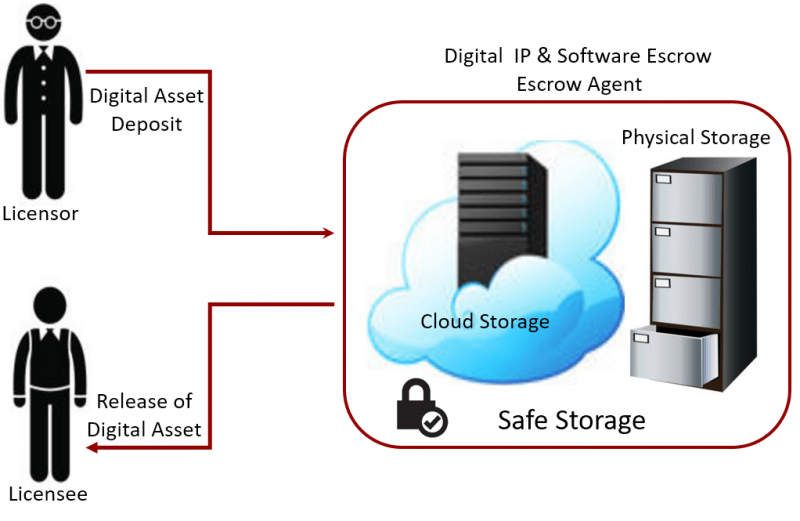In the world of today, Information Technology (IT) runs almost every sector of industry. One of the sectors where IT is most prominent is business. Various business activities are fully run or facilitated by Information Technology. The software branch of IT is often responsible for this activity. In business, transactions mostly occur between two parties. One party expects high quality provision of products or services while the other expects prompt payment.

An example of such a case is where a software is licensed by one party to another. The licensee expects the licensor to maintain and update the software. The licensor on the other hand expects to be paid for this service. In such a business transaction, the source code of the software is held in escrow. This is in case the licensor goes bankrupt or does not maintain the software as promised in the license agreement. On the other hand, the licensor wants the source code in escrow to ensure that the license pays for maintenance efforts.
More about software escrow
Software escrow is the most popular type available today. It is structured such that software source code, which is critical to the mission of a business, can be stored. In addition to software, other resources, such as configuration data, instructions for builds, virtual machines and documentation can also be kept in escrow. Software escrow is versatile. This means that it can be applied in on-premises software, agreements on software developments, software acquisition agreement as well as other software transactions. In most cases, software escrow agencies store applications that are used on-site. However, they can store SaaS applications too.
The main foundation of software escrow is the source code. Also, third party dependencies are a major element in software escrow. If you desire to engage in software escrow, you must have these particular elements of the software ready to submit:
- The internal repository
- Dependencies on third party resources and their license keys
Internal repository
It is important to escrow all the repositories for your software. In the process of a technical verification, professional software escrow agencies notice that clients normally escrow most but not all of their internal software repositories. This compromises the quality of the software held in escrow. Thus, clients are encouraged to perform their own technical verification prior to putting their applications in escrow to ensure that they submit all the required repositories.
Dependencies on a third party
Modern software is normally built using libraries and frameworks from third parties. These can be quite challenging to find after a few years of storing the software in escrow. During the process of release, these third party resources are either difficult or impossible to use. Thus, clients are encouraged to escrow the third party dependencies as well as their license keys.
How does the process of software escrow work?
The negotiation and agreement phase
The first step involves the licensee and licensor entering into an escrow negotiation and agreement. In this negotiation, a condition is set for when the escrow source code should be released. Also, the activities of the licensee are determined after release of the escrow source code. In addition to that, the licensee and licensor agree on how often the escrow source code will be updated. In addition to that, they agree on what type of testing shall be conducted on the escrow source code every time it is updated. After all these items have been agreed upon, the agreement is executed.
The delivery phase
After the licensee and licensor have negotiated and agreed, it is time for the software source code to be delivered to the escrow agent. There are a number of professional software escrow agents today. An example is EscrowTech. This agent receives the source code, its documentation and any other important materials. Upon receipt, the agent conducts a Standard Verification on them to maximize their security. These escrow materials are stored in secure vaults.
Secure holding
After the source code is delivered to the escrow agent, it is held in highly secure vaults. It will stay here until the condition that was mutually agreed upon by the licensor and licensee occurs. When this condition occurs, the source code can be released. In most cases, the condition is the licensor going bankrupt or is unable to perform proper maintenance on the software.
Regular software updates
While the software source code is in escrow, the licensor is supposed to maintain and update it according to agreement. If they honor the agreement, the updates they perform should be applied on the software held in escrow. The software escrow agent should facilitate this. Normally, this is accomplished using an escrow management tool located online.
The release of source code
In some cases, a software license can terminate without the release condition happening. In such a case, the source code can be returned to their vendor or completely destroyed. This depends on the wishes of the licensee or software vendor.
Conclusion
If you are in the business software industry, you understand the importance of applications in boosting business growth. Therefore, software escrow services are a reliable way to guarantee results in these ventures. The process of this facility is indicated above. Software escrow ensures that the licensee and licensor both hold up their ends of the deal.
This Article is contributed by Isabella Rossellini, a software developer. She specializes in business software and hence better knowledge of debt.















